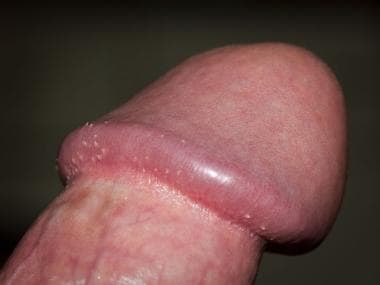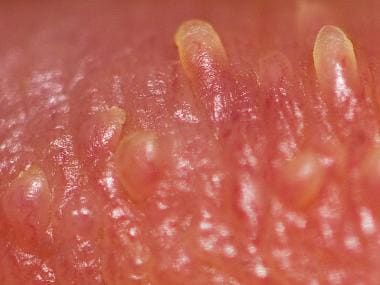Background
Pearly penile papules are small dome-shaped to filiform skin-colored papules that typically are located on the sulcus or corona of the glans penis. Commonly, pearly penile papules are arranged circumferentially in one or several rows and often are assumed wrongly to be transmitted sexually. Pearly penile papules are considered to be a normal variant and are unrelated to sexual activity. Often, lesions cause great anxiety to patients until their benign nature is clarified.
See the images below.
Also see the two related Medscape articles, Dermatologic Diseases of the Male Genitalia: Malignant and Dermatologic Diseases of the Male Genitalia: Nonmalignant.
Pathophysiology
Pearly penile papules are considered a normal variant and harbor no malignant potential. They are not contracted or spread through sexual activity.
Pearly penile papules are observed more frequently in uncircumcised males; however, the mechanisms underlying their development remain unknown. Interestingly, in uncircumcised males with pearly penile papules who undergo circumcision later in life, regression of the papules is commonly observed. [1]
Etiology
Some evidence suggests that pearly penile papules may be observed more frequently in uncircumcised men (22%) than in circumcised men (12%). In the past, pearly penile papules were believed to contribute to the accumulation of smegma in uncircumcised men; currently however, this is known to be not true. [2]
Epidemiology
Frequency
United States
The incidence of pearly penile papules reportedly ranges from 8-48%. [3] Several reports suggest an increased incidence of pearly penile papules in uncircumcised versus circumcised men (22% vs 12%, respectively). One study found an increase in frequency in black versus white men, in those circumcised (21% vs 7%, respectively) and uncircumcised (44% vs 33%, respectively).
International
No geographic variation in prevalence has been noted for pearly penile papules.
Race
No racial predilection has been confirmed for pearly penile papules. Reports suggesting an increased incidence in African American males may reflect an increase in uncircumcised men in that population.
Rehbein [4] studied 840 men aged 10-66 years and found an overall incidence of pearly penile papules of 30.1% in this group. Black men in the study demonstrated a rate of pearly penile papules of 32.7% (44% in uncircumcised, 20.8% in circumcised black males). White men in the study demonstrated a rate of 13.9% (33.3% in uncircumcised, 7.1% in circumcised white males).
Sex
Because of their anatomic distribution, pearly penile papules are noted only in men. However, hirsutoid papillomas of the vulvae, also known as vestibular papillomatosis, is a benign, asymptomatic anatomical variant of the vulvar epithelium present in approximately 1% of women. [5] It is considered the female counterpart of pearly penile papules in men. [6]
Age
Pearly penile papules are noted most commonly in males in their second or third decades of life, with a gradual decrease in frequency with aging. [1, 7]
Prognosis
Pearly penile papules typically are asymptomatic and persist throughout life, although lesions gradually may become less noticeable with advancing age.
Patient Education
Educate patients about the benign nature of pearly penile papules. Inform patients that lesions are not transmitted through sexual activity. Consider counseling for the patient's sexual partner, which often helps alleviate anxiety.
-
Pearly penile papules are seen clinically as multiple, glistening, flesh-colored, dome-topped papules arranged circumferentially in 2 rows along the corona of the glans penis.
-
Pearly penile papules. Courtesy of Wiki Commons
-
Pearly penile papules; close-up view. Courtesy of Wiki Commons.






